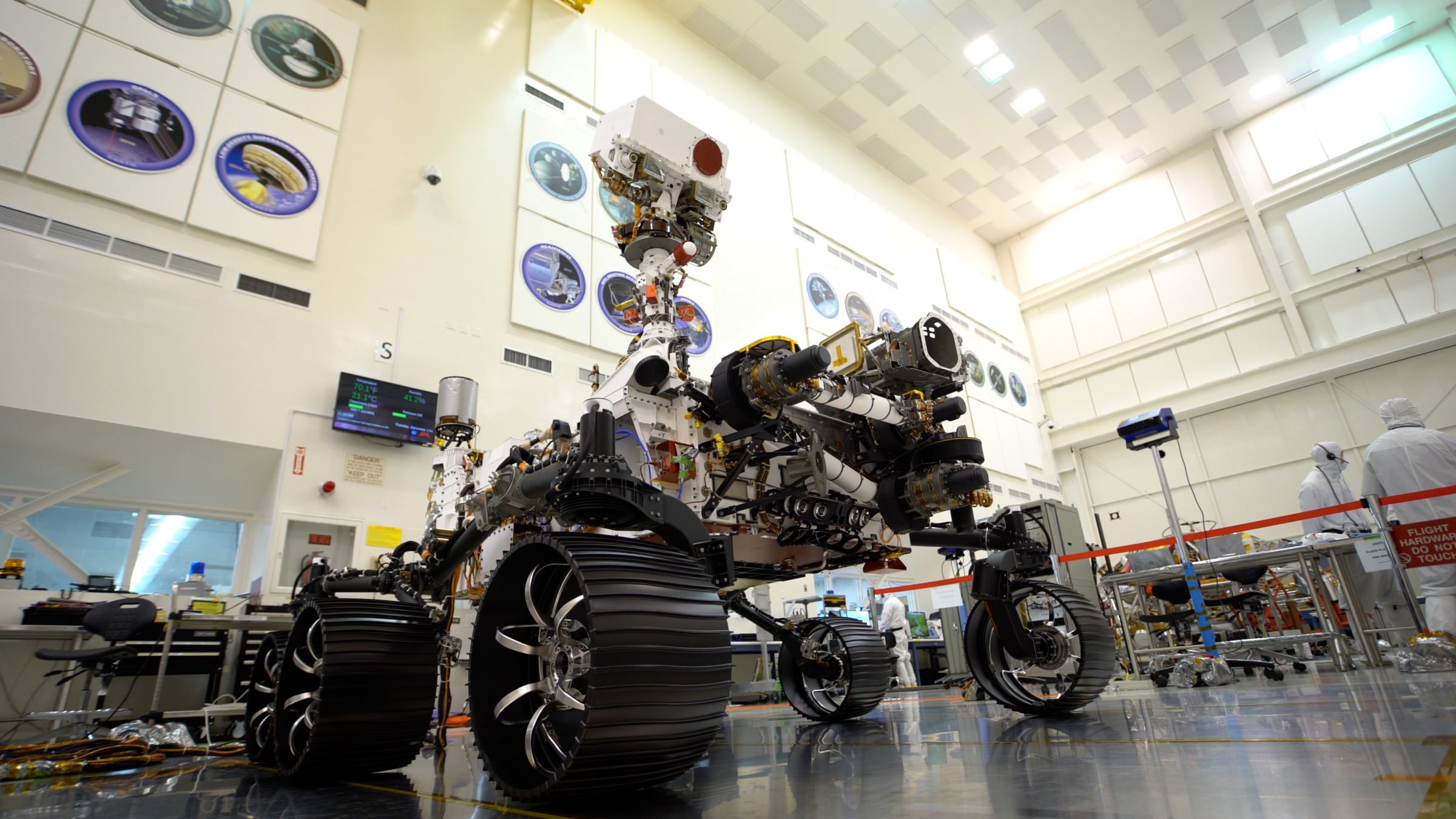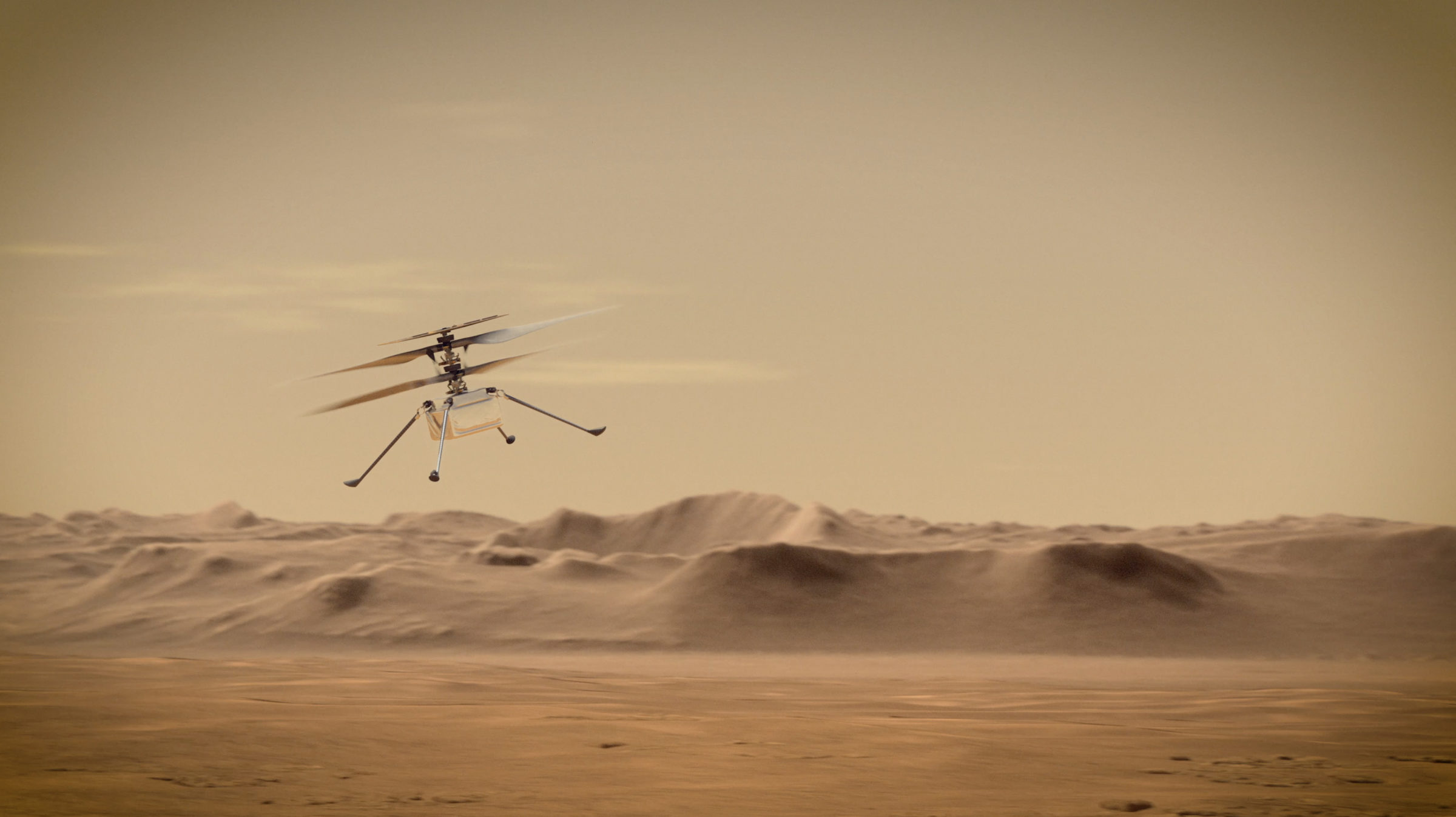Leeham News and Analysis
There's more to real news than a news release.
Built for Mars
By Scott Hamilton
Feb. 17, 2021, © Leeham News: Ever since watching the movie and reading the book, The Martian, I’ve been fascinated about all things Mars.

The Mars rover Perseverance under development at the Jet Propulsion Lab. Source: National Geographic.
Previous movies were contrived sci-fi trash. The Martian was fiction, to be sure, but it was science-based. A NASA official told me the agency cooperated with the book author and the movie producers. And John Shannon, the lead of Boeing’s giant SLS launcher for a Mars mission, also told me the book and movie were based on science.
NASA and Boeing in 2016 outlined some of the challenges in this powerpoint.
Built for Mars is a 90 minute chronicle of NASA’s current mission to Mars. The Perseverance rover is the first of three missions over 10 years to return samples from Mars to Earth for scientific study. Produced by National Geographic and premiering Feb. 18, the challenges of putting together this mission are immense.
Geeks will love Built for Mars
The TV show is not for those looking for excitement or fancy animations on Mars. But space, science and Mars geeks will revel in the detail of what goes into designing the Mars rover and, a first, a small helicopter for use in Mars’ thin atmosphere—just 1% that of Earth’s.

Animation of the first helicopter to operate on Mars. It must do so in an atmosphere that is 1% that on Earth. Source: National Geographic.
The $2.5bn mission designed the Perseverance rover to take some 40 samples of Mars’ earth by drilling small cores. The engineering challenges included making sure there was nothing from our Earth that could contaminate the Mars sample. Earth microbes had to be eliminated. But when testing the system in a special environment designed to simulate Mars’ environment, the core retriever stuck in the tube. The Jet Propulsion Laboratory did such a good job in eliminating Earth microbes that natural lubricants created too much friction.
If a solution wasn’t found, the window to launch the mission from Cape Canaveral would be missed at a cost of $500m and a 26-month delay. Science had to reach a happy medium. It did, and the launch went as scheduled in July last year.
But not without another concern. In February last year, the coronavirus began spreading throughout the US. By the time JPL shipped the rover and small helicopter to Florida, lockdowns were underway. Only the JPL and other essential personnel were allowed to do the final tasks.
A JPL official wryly notes that the name selected for the rover, Perseverance, early in the program proved prescient.
Recreating Mars
JPL and NASA had to create massive chambers and labs to mimic the atmosphere on Mars. They went to Death Valley for testing, substituting the landscape there for the Martian surface. But splitting rocks with a sledgehammer on JPL’s own grounds, called the Mars Yard, also served to mimic rock-strewn Martian surfaces.
This mission, one JPL official said, “outstrips the complexity of anything created and put into space.”
The 10-year mission has three parts. The first is collecting the core samples. The second is putting the sealed samples into space. The third is capturing the sample capsule by another spacecraft and bringing this back to Earth.
Anything could go wrong at any time. If it’s mission-critical, the mission fails.
“It’s not unusual for a Mars mission to flirt with disaster,” a JPL official says. “It’s routine.”
Once you watch Built for Mars, you will understand how easy it is for something to go wrong. And how much innovation and science it takes for everything to go right.


The Martian was a great book and film, as it showed how things might be done in a realistic way. It glossed over some of the remaining challenges, but that was forgivable given the quality of the story and the extensive research that got many things right. Both were enjoyable and instructive.
Perseverance will be a landmark mission, even if it fails at some point. Space is hard, Mars is harder. The Spirit and Opportunity rovers were a minor miracle in their longevity and what they accomplished. I hope the Perseverance mission is equally successful.
I used to work in a pavement analysis lab, and one of our jobs was to go out to the site and drill core samples from the concrete and asphalt.
even drill operators with many years of experience would get about 1 in 10 cores stuck in the drill even with unlimited water flow to keep contaminants out of the barrel.
doing the same thing on mars with a dry bit seems almost ludicrous.
Insight Mission:
As usual if you look at the details it a classic Boeing trail of tears. Huge bucks spent without testing.
The first major mistake was assuming soil type. No, you come up with a system that can deal with all soil types. So the penetration failed.
What was a hoot to read was the statement. Well it was not one of our major expectations it would work. We sent it why?
Please note, it only had 3 major experiments on it, soil temp, quake and a weather station.
The weather station has been done, so call it two.
And in the latest is, we are going to use the arm to bury the wire to the quake sensor as wind is bothering it (they do not say how much and how bad but……)
Note to the team. You know there is wind there from past weather stations and you use a ribbon wire? Right Mel.
In the end we got a weather station, Oh yipppee, been there done that, got T shirts and loads of other science by other units.
If you are going to do this stuff, take the time and do it right.
This is the excuse sheet on insight
https://spaceflightnow.com/2021/01/19/nasa-gives-up-on-salvaging-insight-mars-landers-mole/
The Aliens ate my homework T
The Insight mission has just been extended, as being highly valuable in collecting seismographic data, which is the primary mission, as well as the secondary weather data. This after review by two independent panels of experts, both of whom confirmed the merit of the mission and data.
The drilling mission was always a secondary mission due to the high risk involved. The soil conditions were not certain, and were different than anticipated based on previous experience. It might have also landed above a rock and been unable to drill at all. Nor was there a guarantee they would be able to reach the desired depth. This is why it wasn’t the primary mission.
First it was not a drilling mission, it was a jack hammer.
And yes Rob, we know, you believe anything authorities feed you.
Go fire up your blender and get lots of sugar.
ps: What part about Geology mission do you not understand?
For Perseverance
“The drill is a rotary percussive drill designed to extract rock core samples from the surface of Mars.”
Percussion drilling is well known and extremely noisy, its still a drilling rig not a jackhammer
https://mars.nasa.gov/mars2020/spacecraft/rover/arm/
For Insight , the seismology experiment, the vehicle was Lockheed Martian (pun) not Boeing
NASA and their so called 7 minutes of terror is so absurd, talk about the anti science and pure BS spin.
Machines can be terrorized? Aliens are torturing the computer on the way down?
Its already over when they do or do not get the signal.
Yea you are going to be tense on the actual time of the insertion and then the wait for the report (or lack of one, ask the EU!)
Less time in the PR spin machine and more preparation time for the missions and testing and quit using the orbital alignment as your important benchmark (much like Boeing again, its the time line not the results)
Wait, who is doing the SLS rocket? Ahh yea, that would be Boeing.
TW, really.
The terror is for the NASA and JPL people who put their hearts and souls into this mission, hoping all goes well during the 7 minutes and knowing the least wrong thing can destroy a mission that cost $2.5bn.
Yes, they practice as much as possible, but can’t practice atmospheric entry and landing on Mars. For the Curiosity mission, there was a significant risk of failure of the landing system, which is largely re-used for Perseverance.
It could still easily fail. They deserve great credit for the degree of success thus far, and there should be no recrimination if a failure should occur.
I know what terror is.
sitting waiting for something to work or not work is not terror.
Nervous, yes, lot invested, no problem
Terror is absurd.
You want terror I can recount many tales of that.
Its nothing but NASA bs.
You might want to note the time delay and the so called terror is done deal one way or the other by the time they know.
It worked.
first images available.
nice.
just like my first data from Rosetta. 🙂
First and foremost my hat is off to the EDL group.
They came up with a solution to the landing problem that while horribly complex is the only way to do it. Making that all tick is a stunning achievement.
Then to top it off, the ground mission people want to land it in an impossible area within impossible parameters.
As the EDL guy said, they want to land where I don’t want to. Guess who wins (yea the science is in the tough places to land, drats)
So they modified the chute deplyment to range more accuately, then they came up with a terrain nativgation system to adjsut on the final decent to avoid boulders and other bad stuff).
And they succedded.
Trying to test all that is impossible, garvity alone is impossible.
So, without EDL, there is no mission and I stand in awe (and I seldeom stood in awe of antying I did not matter how good)
The subset is the Copter and how you test that when you can’r educe gaviay. If it fails it won’t be for a lack of Igneiuty (pun intende).
The good part is as a mission sub set, the rest of it does nto depeond on it but if it works its a huge plus as a test let alone future missions. )
The rest looks like good science.
The sample return is pretty iffy. EU involved though hopefully they use the EDL teams system. Onto the planet, pickup- then into orbit, a transfer and back to earth. That is some serious pie in the sky (a direct return wold seem to make a lot more sense and the low gravity would seem to enable that).
The rest of the science looks to be spectacular if it all works.
I grew up on John Carter and probably read every other Mars sci fi since.
And then there is Boeing, sigh
https://spaceflightnow.com/2021/02/20/launch-of-starliner-test-flight-slips-to-april-2/
For those who were not able to make it to Mars to watch the Perseverance rover land, see the link below for video of the landing from cameras on Perseverance and the Skycrane.
https://www.youtube.com/watch?v=4czjS9h4Fpg
Rocket scientists today: https://www.timescolonist.com/mars-rover-landing-a-moment-of-joy-for-canadian-born-nasa-systems-engineer-1.24285017
And for the future: https://cordair.com/artists/larsen/works/the-unknown-awaits/index.html